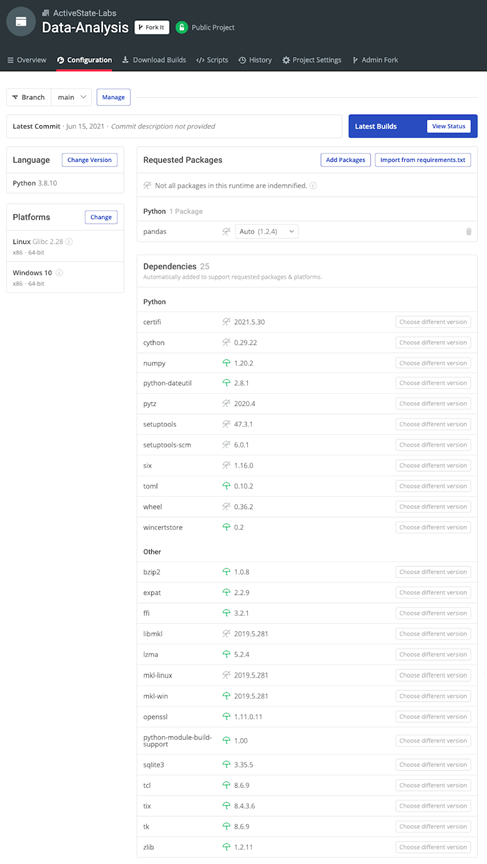How to Check Installed Packages in Conda Environment
The Pip, Pipenv, Anaconda Navigator, and Conda Package Managers can all be used to list installed Python packages.
You can also use the ActiveState Platform's command line interface (CLI), the State Tool to list all installed packages using a simple "state packages" command. For a complete list of all packages and dependencies (including OS-level and transitive dependencies, as well as shared libraries), you can use the Web GUI, which provides a full Bill of Materials view. Give it a try by signing up for a free ActiveState Platform account .
Before getting a list of installed packages, it's always a good practice to ensure that up-to-date versions of Python, Pip, Anaconda Navigator and Conda are in place.
List Installed Packages with Pip
Both pip list and pip freeze will generate a list of installed packages, just with differently formatted results. Keep in mind that pip list will list ALL installed packages (regardless of how they were installed). while pip freeze will list only everything installed by Pip.
For example:
pip list
Output:
Package Version ---------------------------------- ---------- absl-py 0.7.0
pip freeze
Output:
absl-py==0.7.0
List Packages in a Console with Pip
To list all installed packages from a Python console using pip, you can utilize the following script:
>>> import pkg_resources installed_packages = pkg_resources.working_set installed_packages_list = sorted(["%s==%s" % (i.key, i.version) for i in installed_packages]) print(installed_packages_list)
Output:
['absl-py==0.7.0', 'adodbapi==2.6.0.7', 'alabaster==0.7.12', 'alembic==1.0.7', 'amqp==2.4.1', 'anyjson==0.3.3',
List Modules in a Console without Pip
To list all installed modules from a python console without pip, you can use the following command:
>>> help("modules") Note that there are some drawbacks to this approach, including:
- If there are a lot of installed packages, this method can take a long time to import each module before it can search that module's path for sub-modules.
- Modules that have code outside of an if __name__ == "__main__": code block, and if user input is expected, may cause the code to enter an infinite loop or hang.
List Installed Packages with Pipenv
The pipenv lock -r command can be used to generate output from a pipfile.lock file in a pipenv environment. All packages, including dependencies will be listed in the output. For example:
pipenv lock -r
Output:
-i https://pypi.org/simple certifi==2019.11.28 chardet==3.0.4 idna==2.9 requests==2.23.0 urllib3==1.25.8
List Installed Packages with Anaconda Navigator
To list installed packages in an Anaconda environment using Anaconda Navigator, do the following:
- Start the Anaconda Navigator application.
- Select Environments in the left column.
- A dropdown box at the center-top of the GUI should list installed packages. If not, then select Installed in the dropdown menu to list all packages.
List Installed Packages with Conda
The conda list command can be used to list all packages in a conda environment:
conda list
Output:
# packages in environment at C:\Anaconda2_4.3.1: # _license 1.1 py27_1 alabaster 0.7.9 py27_0
Globally vs Locally Installed Packages
For information about generating a list of installed packages globally vs locally, refer to:
How to List Globally Installed Packages vs Locally Installed Packages in Python
List Installed Packages with the ActiveState Platform
To view a list of installed Python packages in your currently active project using the ActiveState Platform, run the following command on the command line:
state show packages The output is a full list of installed packages in your current project:
matplotlib numpy pandas scikit-learn scipy
You can also obtain a complete software bill of materials view of all packages, dependencies, transitives dependencies (ie., dependencies of dependencies), OS-level dependencies and shared libraries (ie., OpenSSL) using the ActiveState Platform's Web GUI:

How to Check Installed Packages in Conda Environment
Source: https://www.activestate.com/resources/quick-reads/how-to-list-installed-python-packages/